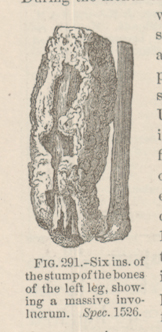Title: Cavanaugh, J.
Source text: The Medical and Surgical History of the War of the Rebellion. (1861-65.), Part 3, Volume 2 (Washington, DC: Government Printing Office, 1883), 492.
Civil War Washington ID: med.d2e19287
TEI/XML: med.d2e19287.xml
CASE 742.—Private J. Cavanaugh, Co. C, 7th Wisconsin, aged 27 years, was wounded before Petersburg, June 18, 1864, by a shell, which caused a fracture of the lower portion of the left leg, involving the ankle joint. Surgeon C. N. Chamberlain, U. S. V., reported that the injured leg was amputated at the field hospital of the 4th division, Fifth Corps. Surgeon B. B. Wilson, U. S. V., contributed the pathological specimen, No. 1526, Surg. Sect., A. M. M., shown in the adjoining wood-cut (FIG. 291), and reported the following history of the case: "The patient was admitted to Stanton Hospital, Washington, from City Point, July 1st. He had suffered amputation of the leg at the lower third, by the circular method, the day after he was wounded, being, according to his statement, in a high fever at the time of the operation. He was treated with stimulants, and ice dressings locally. During the month of September the limb became much swollen and abscesses formed in the line of the middle third of the bone, which, after discharging, left fistulous openings, clearly indicating necrosis of the shaft of the tibia. His term of service having expired, the patient was discharged October 5, 1864, but being unable to leave, he was retained as a patient in the hospital. The shaft of the tibia being evidently extensively necrosed, I determined to perform another amputation above the diseased portion. This operation—though opposed by the medical staff of this hospital and by Surgeon A. N. Dougherty, U. S. V., as well as Surgeon T. F. Betton, 1st U. S. V. V., who saw the case—was preferred by me to that of exsecting the sequestrum for the reason that it involved no more danger and would give the patient a much better stump (though six inches shorter) for fitting an artificial limb. The operation was performed one inch below the tubercle of the tibia, by the circular method, on February 25, 1865, and the stump was treated with cold-water dressings. Traumatic erysipelas followed (an epidemic of erysipelas breaking out in the hospital the same week), and for a few days fears were apprehended as to the result. The patient, however, made a good recovery, and by March 15th the inflammation, which had extended to the abdomen, had subsided. Before he finally left the hospital the patient received an artificial limb, on which he walked with great ease and comfort. The specimen indicates clearly and in a marked degree the efforts of nature in throwing off dead bone and supplying its place by new growth. The adventitious process, thrown out to unite the amputated ends of the tibia and fibula and thus give the extremities of those two bones firmness and solidity, shows to how great an extent the reparative process can be carried. By what agency the want of bony matter at this point was perceived and its deposit determined at the proper place and in the proper form is beyond the scope of human knowledge at the present time. The fact, however, evidences the powers of nature to accommodate herself to circumstances and to repair in a limited degree the effects of losses which are irremediable." The specimen, consisting of the re-amputated stumps of the bones of the leg joined by osseous deposit at their lower extremities, shows a massive involucrum except on the anterior border, where a heavy sequestrum is visible. The patient became a pensioner after leaving the hospital. On September 2, 1874, he was examined by Dr. C. F.Falley, pension examiner at Lancaster, Wisconsin, who certified to the loss of the leg and reported: "The amputation has left rather an irritable stump, but, as his cork leg does not press on it, I do not think it any great injury in wearing an artificial limb. He can flex and extend the stump freely," etc. The pensioner was paid March 4, 1880. In his application for an artificial leg he reported that Surgeon D. C. Ayres, 7th Wisconsin, performed the first amputation.
